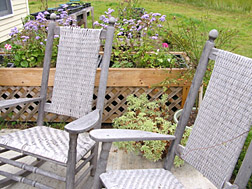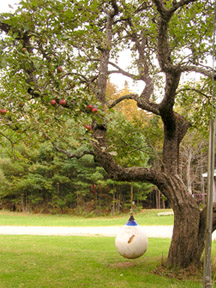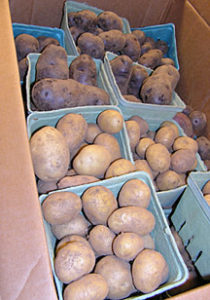 |
| At Islesboro Central School, a hoop house protects warm weather crops in the summer and is slid over the plot of greens for an extended fall harvest. The plastic net fencing keeps out deer. |
Story and photos by Jean English
Bob Berg, a cheerful, older man, drives up to the Islesboro Central School (ICS) parking area, opens his trunk, and transfers tomatoes, leeks, cucumbers and other fresh, colorful vegetables from the back of John Pincince’s truck. “Do you come to Islesboro for the summer?” I ask Bob. “No,” he answers, his eyes sparkling. “I come for the vegetables!”
Lots of locals (summer folks included) are talking about the fresh, local vegetables that are increasingly available on the island off Midcoast Maine, thanks largely to the horticulture program taught at the K-12 school by Pincince (and originated by Steve Miller, of the Islesboro Island Trust). At one point or another, most of the 82 ICS students will participate in the program.
 |
| Horticulture teacher John Pincince in his basement classroom. |
Islanders are talking about fruits, as well, as a result of The Orchard Project. This outgrowth of the horticulture program is located on a 1-acre plot owned by the school. The goals of the Orchard project include fostering local and sustainable agriculture on Islesboro. In addition to the usual benefits of a local food supply – better taste, greater nutrition, increased security – ferrying food 3 miles from Lincolnville to Islesboro aboard the Margaret Chase Smith just adds to the cost of “imported” food.
The initial horticulture program, which is still very much a part of the overall program at the school, was collaboration among the Region 8 Mid-Coast School of Technology in Rockland; the Islesboro Island Trust; and the ICS horticulture program.
 |
| John Pincince with a young ‘Reliance’ peach in the Islesboro Central School orchard. |
From Kitchen Garden to Organic Farmer/Teacher
Pincince says he “grew up with a kitchen garden” in Rhode Island, where his Quebec-born parents had settled. French was his first language, and fresh tomatoes, cucumbers, peppers, parsley – “all the basic things” – were among his first vegetables. He always helped in the garden. In summers, he visited his uncle’s Quebec dairy farm, which produced milk, corn, hay and a big family garden.
His interest in the natural world was further fostered at the University of Montana, where he earned a B.S. in Natural Resources Management, then conducted wilderness inventories for the Bureau of Land Management – “a dream job” until Reagan-era cuts.
 |
| The Islesboro Central School, a “summer cottage” constructed mainly from island limestone in the 1930s, was donated to the town for a school. The Kinnicutt Center on the left was added in the 1980s. |
So Pincince returned to New England, worked the potato and blueberry harvests, and “really liked Maine.” For a decade he had a landscape gardening company in St. George, and during that time he earned a Master’s in Teaching and Learning from the University of Southern Maine. Just after he and his wife, Lucy, moved to their Ashgrove Farm and Gardens in Lincolnville in 1997, the horticulture position on Islesboro opened, and he was hired by the Region 8 Mid-Coast School of Technology to teach there.
The High School Program
The one-year, high-school level, elective horticulture course at Islesboro, funded by Region 8, covers basic botany, plant taxonomy, soils, fertilizers, composting, vegetable gardening, greenhouse systems, landscape design and plants, tree identification, plant propagation and pruning, and forest management (the school has 7 acres of land). “I try to make it as local as possible but still applicable to other places,” says Pincince. Students who elect the course for a second year may delve more deeply into entomology, diagnosing plant problems, and/or do independent projects.
 |
| A second hoop house was planted with cold-weather greens in October. |
“I admit to [the students] my strong bias toward organic,” Pincince emphasizes, and all gardening done in the course is organic. Many of his lessons come from Cooperative Extension’s Master Gardening materials, supplemented with his own experience and other materials, such as videos about genetic engineering.
His basement teaching room is small and has remarkably tiny windows for a place where plant growth is taught, but Pincince has opportunistically turned an adjoining room into a propagation area, where seedlings and cuttings are raised under lights. Ever resourceful, he and his students solved a damping off problem in the small, still room by setting several fans from old unused computers just below the grow lights and by sprinkling powdered charcoal on the potting soil. Yet another basement room may become a root cellar.
 |
| Horticulture students made a mile of woodland trails through the school property, then made signs for the trails. |
Students spend some 75% of their time outdoors, in about 1,000 square feet of vegetable gardens; along the mile of nature trails they created through the school’s forest; and tending the orchard and local fruit trees. They also created raised beds (from bait tubs, fittingly) for Boardman Cottage, an island residence for the elderly.
 |
| Raised beds that students made from bait tubs are appropriate for the island’s elderly residents at the Boardman Cottage. |
Fresh Vegetables, No Chicken Nuggets
Vegetables are grown in two outdoor beds and under two hoop houses, “Coleman style” – with a single layer of plastic on the house and a layer of Agribon fabric over wire hoops closer to the ground for extra warmth. Greens (mache, mesclun, chard, etc.) for the cafeteria salad bar grow in a hoop house during cold, spring weather. The house holds tomatoes and other warm weather crops in the summer and early fall, while greens grow in an adjacent, uncovered plot. When fall arrives, the house is moved back to the plot containing greens. A second, donated house was planted with claytonia, mache and spinach on Oct. 10. Potatoes and tomatoes are raised among young orchard trees.
Even these hoop houses have to be fenced – as Pincince learned after deer dined on much of the salad crop in one house. Plastic mesh deer fencing has worked well since.
 |
| Students dig in to the school-grown salad. |
These gardens supply the cafeteria with salad crops into November and sometimes later; and begin again in mid- to late-February. Wendy Sawyer, head cook at ICS, is thrilled to have the beautiful, fresh produce. She previously owned and ran the Snack Shack on the island, so she knows how precious quality, locally-grown produce is. “Just the beauty of [the vegetables]…” she says. “It’s so nice to have someone [like Pincince] who knows vegetables. Anytime he has anything, I say ‘Yes!’ I’ll blanch and freeze it; I’ll even can! And I don’t have to worry about chemicals [pesticides].” She adds, “I don’t like taking chicken nuggets out of the freezer. I’d rather chop onions, peppers, mushrooms – real food.”
 |
| Head cook Wendy Sawyer says “Yes” to all produce the students grow. If she can’t use it soon, she’ll freeze or even can it. |
Sawyer notes that her off-island distributor supplies only romaine and iceberg lettuce. “The red and green mix [from the school gardens] looks so nice. I think everybody eats with their eyes. I’ve had rave reviews from the kids. Out of 82 enrolled, we serve an average of 72.” Pincince estimates that the horticulture program currently provides up to 10% of the produce used in the cafeteria.
Valuable Island Trees Populate the Orchard
The Orchard Project, intended to supply fruit for the school and the island’s farmers’ market, began in 2001 with a $2,000 grant from Maine Initiatives and funds that students raised by recycling ink jet cartridges. Another $1,000 came from Islesboro resident Apple Bartlett’s annual fundraising Dog Show, and Maine Initiatives continued its support in 2005, with an added $1,000 grant. The New England Grass Roots Environment Fund also granted $2,000 to the project.
 |
| Elementary school students made scarecrows that moved to protect the orchard. |
Volunteers from the community, using their own equipment, cleared, stumped and graded the 5/8-acre site – after students surveyed the land with Tom Tutor, the ICS math teacher. Later students “cruised” the area with Dave Freidricks, an island forester. Cedar posts were cut from school grounds and, with permission, from an island resident’s woods. White cedar grows abundantly on the island’s limestone soils. With these posts, an 8-foot deer fence was erected.
Pincince is pleased that so many of the 600-plus year-round community members were involved, including students, teachers and teachers’ spouses. “Almost all of the school has been involved in planting the orchard,” he notes. “Even the elementary grades made scarecrows. The challenge for them was to make something that would spin or move.” Some people exchanged labor for wood that was harvested from the site.
 |
| This large apple tree is one of several that horticulture students have pruned on Islesboro. |
Pincince himself dowsed for a well; now the 72-foot well gives 45 gallons of water per minute. A solar-powered pump will deliver this water through drip irrigation tubing to the orchard trees – with students using algebra to figure energy needs, flow rate, etc. A student and his carpenter-father have designed an 8 x 12 shed to protect the well and pump. Money for the pump, well house and orchard tools came from a fundraising letter and brochure that Pincince sent to islanders.
A Wellscroft wire mesh deer fence surrounds the orchard, and to date 16 fruit trees have been planted, including ‘Red Bartlett’ and ‘Dana Hovey’ pear; ‘Reliance’ peach; ‘Winthrop Greening,’ ‘Black Oxford,’ ‘Isaac Newton,’ ‘Newt Grindell,’ ‘Ida Red’ and ‘Dudley Winter’ apples, and more. Apples are planted on standard, semi-dwarf and dwarf rootstock. A semi-dwarf ‘Honey Crisp’ apple tree, planted in honor of former ICS principal John Kerr, who now teaches at nearby Camden Hills Regional High School, was the first tree to fruit – in its third year. Pincince hopes that the rest of the trees will be fruiting by their sixth year.
The label on one apple tree reads, “‘Tastes like pear’ apple from across from yellow house.” “I know where that is,” says Pincince. “It might be a ‘Permain’ apple.” This tree is the fruit of yet another project: One of Pincince’s second-year students, Olivia Boucher, is using Global Positioning System technology to map old fruit trees on the island. (She is also photo-documenting the horticulture program’s work and developing its Web site.) Worthwhile trees are identified (if possible), scions (pieces of one-year-old growth) are cut and grafted onto rootstock, and the resulting young trees are planted in the orchard.
‘Island Cortland’ is the next Islesboro-originated tree, followed by ‘Lyman South Side,’ from the south side of a home owned by the Lymans. “John [Bunker] was impressed with this,” says Pincince. Bunker, a pomologist and Fedco Trees coordinator, helps identify trees on the island and, after one tour four years ago, suggested several specimens for Pincince and his students to collect. He later grafted these with his students. Pincince and his students continue to collect scion wood in the winter. They also prune fruit trees during the winter, in order to learn the skill and to help keep local trees productive. Pincince shows me a large, old tree that his class pruned – “in exchange for applesauce.”
Pincince hopes to start a fall festival, with an apple pie contest, cider pressing and other events, “to bring people together around locally grown food,” and to save some of the old, tasty, potentially unique varieties in yards and old orchards on the island. He already presses apples with his students, using a donated press. They avoid pathogens by using only apples from trees (no drops), washing them in water and Dr. Bronner’s soap, then rinsing them in clean water.
The orchard will ultimately hold 30 to 50 trees. A few crabapple and American chestnut trees planted outside the deer fence soften the “concentration camp” effect of the fence.
 |
| Potatoes from the alley-cropped orchard will be cooked and served in the school cafeteria. |
Pincince adopted the alley cropping system he’d seen at MOFGA’s Common Ground Education Center: He and his students planted potatoes and tomatoes between rows of fruit trees to take advantage of that space while the trees are young. They plan to produce more vegetables, and raspberries, highbush blueberries, elderberries and strawberries among the trees in subsequent years. A cover crop of winter wheat and rye is keeping the soil in place this winter, and, when tilled in the spring, will add nutrients that were retained in the plants over winter, and organic matter.
As Pincince wanders the orchard, he talks about ideas he learned from New York orchardist Mark Phillips at the Common Ground Country Fair – about fruit trees being forest edge plants that will do best with a variety of plants growing around them, such as goldenrod, clover and comfrey; about the potential for using scraps of gypsum sheetrock as mulch and a calcium supplement around trees. (Gypsum – calcium sulfate – does not change the soil pH, so it’s a better source of calcium than lime if the soil pH is already high enough.)
Like all of us, Pincince and his students learn from their mistakes as well. Last spring he was late getting plastic mouse guards off trees, and round-headed apple tree borers took serious advantage of the protected environment. Next year he plans to remove mouse guards sooner and put wire mesh screening on for the summer.
Trees are mulched and fertilized with compost (some made on-site; some from Kinney Compost of Knox), bark chips and aged horse manure.
Summer Care
While Pincince tends his own farm in Lincolnville in the summer, the gardens and orchard receive some care from one or two students supervised by Steve Miller of the Islesboro Island Trust, which has worked closely with the program since its inception. As Miller has had increasing demands on his time and as the program has grown, Pincince has seen a need for a college student to work full-time for eight weeks in the summer garden and orchard. The student would tend the gardens, orchard and hoop houses, and harvest and sell produce through a small, two- or three-member CSA. The student would have housing for the summer and would be paid with the CSA income and, perhaps, by a grant. In the fall, the school would receive the vegetables.
Such an arrangement would have helped last summer, when leaf rollers defoliated many fruit trees. “I think Dipel would have worked if it had been applied at the right time,” says Pincince.
More than Markets
The main market for ICS produce is the school cafeteria. Excess is sold at the entrance to the school during the school year; at a town farmers’ market outside Craig Olson’s Artisan Books & Bindery during the summer (on Tuesdays, from 10 to 1); at the Islesboro Island store; at the golf club; and in the future, Pincince hopes, through the CSA mentioned previously.
While the horticulture program is delivering fresh, healthful foods, its main purpose is to teach – and Pincince sees that as a very important goal. “I hope some students will do a big market garden someday. Some have gone on to work on some of the estates here.” In fact, the main careers on the island include lobstering, caretaking summer residences, carpentry, plumbing, boat building and repair, and landscape gardening. Pincince “helps kids be able to have meaningful jobs here,” says fellow teacher Ginny Drew.
Professor to the Lower Grades
 |
| Art students, directed by Shar Piper, created some never-before-seen insects that, fortunately, stay out of the garden. |
The horticulture program, farmers’ market, cider pressing and potential CSA would seem to be enough for one teacher. But Pincince is involved in the K-8 curriculum at ICS as well. Jan Dooley, who teaches fourth and fifth grades, has her class broken into Harry Potter-style “houses,” with houses earning points as incentives. Pincince helps bring the magic of those books alive. “Professor Pincince does herbology with us,” says Dooley, smiling at the thought of the “professor” in his velvet cape and hat. At Christmas, the class makes “magic, healing lip balm” with mint grown, harvested and dried by students. When Pincince teaches soil testing, he “makes it like magic.” He’s had younger students plant a pizza garden and pick potatoes. On May Day, the older students share their work with other students and the community at the school’s annual May Day festival.
“He’s beautified so much of the school,” says Dooley, “and we have the best salads at this school!” The horticulture program, she adds, “is such a gift from Region 8.” Pincince’s personality is another gift: “He’s incredibly patient. He has a Zen-type character. All the kids relax in his care.”
Back on the Farm
On his own Lincolnville farm, Pincince and his wife raise an acre of certified-organic produce and flowers. They sell cut flowers to B&Bs, restaurants and, last year, to a wedding party on Islesboro. Vegetables go to the The Edge Restaurant in Lincolnville, to the Islesboro summer farmers’ market and to other island customers – such as Bob Berg.
 |
| A welcoming display at the entrance to the Islesboro Central School. |
Tending his own farm must give Pincince the time to think…of yet more projects for Islesboro. Given more help, “I could see layers and meat birds; an expanded CSA; a bigger farmers’ market; other people growing stuff for sale…” His students have a good head start on those and many other possibilities.

